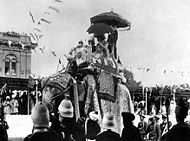
H. S. Bhatavdekar
Encyclopedia

Film
A film, also called a movie or motion picture, is a series of still or moving images. It is produced by recording photographic images with cameras, or by creating images using animation techniques or visual effects...
(motion picture) in India.
Biography
H. S. Bhatavdekar was a resident of MumbaiMumbai
Mumbai , formerly known as Bombay in English, is the capital of the Indian state of Maharashtra. It is the most populous city in India, and the fourth most populous city in the world, with a total metropolitan area population of approximately 20.5 million...
(Bombay). A portrait photographer by occupation, Bhatavdekar was one of the first witnesses to the Lumiere Brothers film show in 1896 in Mumbai. He soon acquired a movie camera
Movie camera
The movie camera is a type of photographic camera which takes a rapid sequence of photographs on strips of film which was very popular for private use in the last century until its successor, the video camera, replaced it...
from London and a projector
Video projector
A video projector is an image projector that receives a video signal and projects the corresponding image on a projection screen using a lens system. All video projectors use a very bright light to project the image, and most modern ones can correct any curves, blurriness, and other...
and went on to make some films on day-to-day life of the city as also some important events.
First film to be shot by an Indian
"The Wrestlers" was shot during a real wrestling match in Mumbai and thereby became not only the first film to be shot by an Indian, but also the first "Reality (DocumentaryDocumentary film
Documentary films constitute a broad category of nonfictional motion pictures intended to document some aspect of reality, primarily for the purposes of instruction or maintaining a historical record...
) Film" of India.
H. S. Bhatavdekar's later films also were all reality films, with (See Filmography below for full titles-) "Local Scenes...", "Sir Wrangler..." and "Delhi Darbar..." being of historical significance; since important personalities like R. P. Paranjpe
R. P. Paranjpe
Sir Raghunath Purushottam Paranjpye was the first Indian to achieve the coveted title of Senior Wrangler at the University of Cambridge, and became a university administrator and Indian ambassador....
can be seen landing in India from a ship; and the actual proceedings of the Delhi Durbar
Delhi Durbar
The Delhi Durbar , meaning "Court of Delhi", was a mass assembly at Coronation Park, Delhi, India, to mark the coronation of a King and Queen of the United Kingdom. Also known as the Imperial Durbar, it was held three times, in 1877, 1903, and 1911, at the height of the British Empire. The 1911...
(Delhi Royal Court). Bhatavdekar also filmed Lord Curzon at the coronation of King Edward VII in Kolkata
Kolkata
Kolkata , formerly known as Calcutta, is the capital of the Indian state of West Bengal. Located on the east bank of the Hooghly River, it was the commercial capital of East India...
(Calcutta) in 1903. Therefore, he can be called as the First Documentary Filmmaker of India, it is also considered India's first Newsreel.
Filmography
(as a director)- The Wrestlers (1899),
- A man and his monkeys (1899),
- Local Scenes: Landing of M. M. Bhownuggree (1901),
- Atash Behram (1901),
- Sir Wrangler Mr. R. P. Paranjpe (1902),
- Delhi Durbar of Lord Curzon (1903), and
- Delhi Durbar (1903/I).
H. S. Bhatavdekar is not known to have made any long duration "feature films".

